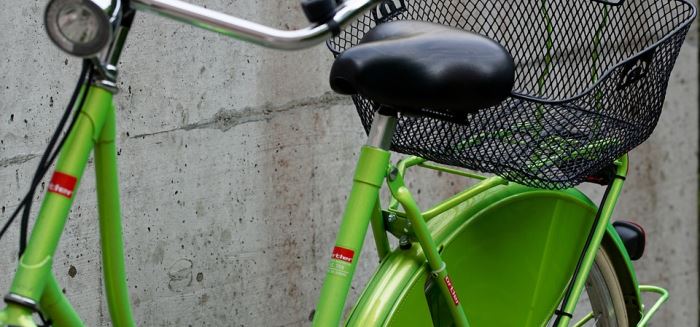The negative impact of experimental projects, especially in business, is typically measured financially. Yet whether there are gains or losses in the view of the stakeholders, the broader community is often left to deal with increased material burdens on transportation and waste management. Reflecting on Jonathan Malesic’s account of citywide bike-sharing, let us consider how stewardship expands our definition of stakeholders.
Yours truly,
Adam Copeland, Center for Stewardship Leaders
Sharing Bicycles, Sharing Waste
Jonathan Malesic
The brightly-colored bikes started appearing all over my Dallas neighborhood in summer 2017. I’d see a dozen neatly lined up outside a 7-11, thirty by the Apple Store, and single bikes on streetcorners and lawns as I walked to the supermarket. A yellow bike lay on its side in the stairwell of my apartment building for several days. I went away for two weeks; it was still there when I came back.
Several companies rolled out these bikes for Dallasites to rent and ride wherever they wanted. Each bike’s rear wheel has a lock riders can open using a smartphone app. When you finish riding, you click the lock back into place and walk away. The app processes your payment.
It must have seemed like a good idea in a pitch meeting. Riders would be able travel point to point within the city without having to worry about bus schedules, parking, or theft. At one point, there were 18,000 of these bikes in Dallas, more than any other U.S. city.
I started Instagramming the bikes, to document their ubiquity and strange beauty. No one seemed to know where to leave them. So they just left them wherever. The bikes often blocked sidewalks. Or they’d be tucked away in alleys. People kept bikes in their garages, effectively making them their own. Eventually, bikes ended up where no one could use them: up trees, in dumpsters, at the bottom of lakes.
The bikes landed in the odd interstices of the cityscape perhaps because they exist in a gap between private and common property. Like anything for rent, the owner isn’t the user. The owner’s interest is in unused bikes being just where potential riders would want them, and to the bike companies, we’re all potential riders. But the riders’ interest is in leaving bikes closest to where they were last using them. And non-users’ interest is in them being unobtrusive. It’s impossible to satisfy these conflicting desires.
The bikes thus became a massive negative externality. That is, a major cost of the companies’ business was borne by society at large, not by the owner or user. In that sense, unused bikes were like pollution. If there were 50 pounds of discarded household trash on the sidewalk, we would hold whoever left it there accountable. But the bikes don’t look like garbage; their owners might say they are always potentially useful.
Even so, they’re terrible as bikes. They’re bulky and have inconvenient gears and solid tires that offer no cushion against pothole-pocked roadways. And the drivers on those roadways aren’t friendly to cyclists anyway. There are few bike lanes on Dallas streets.
The city eventually cracked down on the bike-share companies, and a few of them pulled up stakes. The bikes themselves were junked. In China, where this form of bike-sharing originated, bikes piled up outside parks and train stations, then piled up in giant landfills.
The companies started up with billions of dollars in venture capital, an industry that expects a series of expensive failures to precede a single world-changing idea. Investors need a tolerance for risk, but the bike-share fiasco shows they also depend on a high tolerance in the broader society for waste.
Most of the bikes are now gone. Instead there are motorized scooters, also for rent by app. I see people — all younger than me, between age ten and thirty — zip down the street, often in groups, smiling, sometimes racing. I admit, it looks fun. The scooters are all over. Every corner. The middle of the sidewalk. Down the storm drain. At the bottom of the lake.
About the Author
Jonathan Malesic’s writing about work, religion, education, and culture has appeared in The New Republic, America, Commonweal, Washington Post, Hedgehog Review, Chronicle of Higher Education, and other publications. He is the author of Secret Faith in the Public Square: An Argument for the Concealment of Christian Identity(Brazos, 2009). He holds a Ph.D. in religious studies from the University of Virginia and teaches first-year writing at Southern Methodist University. He lives in Dallas.

